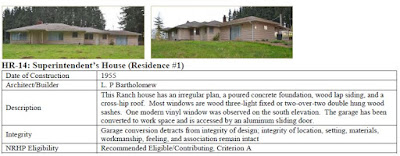 |
| The first building at Hillcrest was a Knighton It looks like it could be cleaned-up and restored! |
 |
| April 13th, 1914 |
 |
| It is considered eligible for the National Register of Historic Places |
 |
| Also considered eligible |
Over at Hinessight they've got ideas about the City of Salem buying the whole campus. One of the champions suggests a path or linear park concept.
The Trail System portion of the Master Plan identifies a trail along Reed Road on the property. The city already has parkland along Reed Road near Battle Creek Road, so the city could complete the multiuse trail paralleling Reed Road and save millions by not having to do a full build of Reed Road to accommodate curbs, drainage, sidewalks and bike lanes. [link added]One of the things about paths in undeveloped areas is that they aren't going to get much use after dark. As such, while they might be great for fair weather and daylight tooling around, they do not function as replacements for on-street facilities. We put bike lanes on streets because they connect to places people want to go, and appropriately calmed car traffic also offers safety in other eyes and ears. When there is finally a commercial hub in the Fairview project, people will want to walk and bike to that, and a path system off of Reed Road will provide inferior connections, and ones, again, that may not feel very safe after dark.
It's also not clear that the City would save millions. Private developers are required to make half-street improvements on their sides of Reed Road as their projects move along. The City is not funding the build out of Reed Road, I don't believe.
As for the Housing Authority, this land is not yet near a grocery store, and for most things it will be car-dependent. Maybe jobs in the Fairview Industrial area would be easy to walk or bike to, but little else. If Costco moves in, crossing Kuebler will daunting for many. Cherriots serves the neighborhood on Route 6, but offers only hourly service at the moment. It is minimally connected by transit.
This does not seem like a site well suited to subsidized or other affordable housing projects.
Maybe there are other reasons that would make it a good idea, but it does not seem like an obvious candidate for public purchase at the moment. It will be interesting to see if the idea gains traction and is refined through further conversation and debate.
Addendum
This is more of a footnote than anything larger, but is interesting to note minor lack of consistency between the Transportation System Plan and the Parks Master Plan.
 |
| Standard bike lanes for Reed Road in the TSP (2017 version) |
 |
| Concept for a longer off-street trail (green dots) in Parks Master Plan (2013) |


1 comment:
(Added clips from City's Transportation System Plan and Parks Master Plan.)
Post a Comment